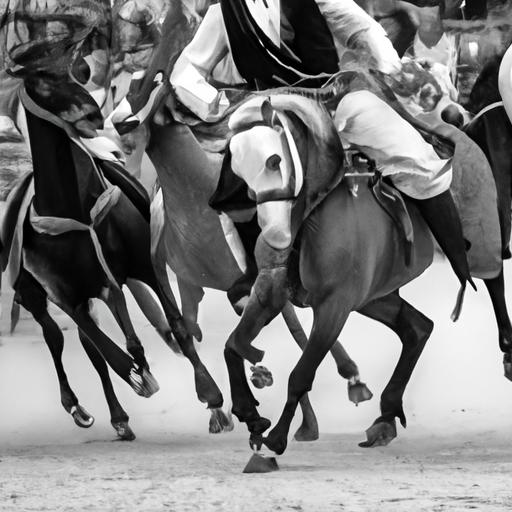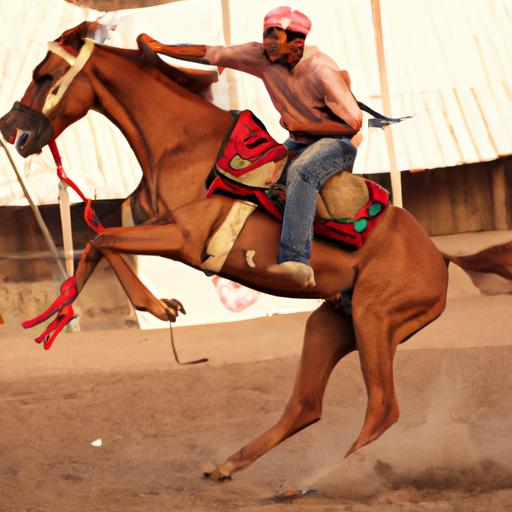Discover the cultural and economic impact of horse fighting sport. Explore its significance, tourism benefits, and preservation of cultural heritage.
Horse Fighting Sport has long been a captivating spectacle deeply rooted in history and culture. But what exactly does this term entail? Let’s begin by defining this traditional sport. Horse Fighting Sport refers to a unique form of competition where two stallions engage in a fierce battle, showcasing their strength, agility, and dominance. While it may raise eyebrows due to its controversial nature, it is essential to delve into the historical and cultural significance that has preserved this tradition for generations.
Throughout time, various cultures have embraced Horse Fighting Sport as a testament to their heritage and values. In many regions, such as the Philippines and some parts of China, this sport holds a special place and is seen as a symbol of bravery, honor, and masculinity. The history of Horse Fighting Sport can be traced back centuries, and its roots intertwine with local folklore and customs. This sport often becomes an embodiment of cultural identities, with rituals and ceremonies accompanying the events.
So why has Horse Fighting Sport managed to withstand the test of time? Beyond its historical significance, this sport serves as a platform for communities to come together, celebrate their shared traditions, and foster a sense of belonging. The spectators become immersed in the vibrant atmosphere, embracing the excitement and thrill as they witness these majestic creatures engage in an intense battle. The horses themselves are revered as symbols of strength and power, embodying the spirit of the sport and captivating the hearts of all those who witness their prowess.
In the next section, we will explore the controversy surrounding Horse Fighting Sport, addressing the concerns raised by animal rights activists and examining the arguments against its practice. Join me as we delve deeper into this multifaceted topic, understanding the perspectives from both sides of the debate.
The Controversy Surrounding Horse Fighting Sport

A. Animal Rights Concerns
As with any sport involving animals, Horse Fighting Sport has faced significant backlash from animal rights activists. They argue that the sport exploits and subjects horses to unnecessary harm and distress. Concerns are raised regarding the physical injuries sustained by the horses during the fights, ranging from cuts and bruises to more severe injuries. Critics also express their worry about the psychological impact on the animals, as they are forced into aggressive encounters that go against their natural instincts.
B. Arguments Against the Sport
Opponents of Horse Fighting Sport highlight several key arguments against its practice. They assert that it promotes animal cruelty and violence, as horses are pitted against each other solely for human entertainment. Additionally, the lack of consent from the animals involved raises ethical questions, as they are unable to voice their preferences or consent to participate. Critics argue that alternatives, such as non-violent equestrian competitions or exhibitions, can preserve cultural traditions without causing harm to the animals.
C. Legal Status and Regulations
The legal status of Horse Fighting Sport varies across different jurisdictions. In some countries, the sport is outright banned due to animal welfare concerns. However, in regions where it is still practiced, regulations have been implemented to mitigate potential harm to the animals. These regulations often focus on ensuring the well-being of the horses, including mandatory veterinary checks, limitations on the duration of fights, and the prohibition of cruel practices. Striking a balance between preserving cultural traditions and safeguarding animal welfare remains a critical challenge for legislators and stakeholders involved in the sport.
In the next section, we will explore the traditional practices of Horse Fighting Sport, shedding light on its historical evolution and the traditional rules and setup of the sport. Let’s dive into the rich tapestry of its origins and the role of horses in this captivating spectacle.
Traditional Horse Fighting Sport Practices
Origin and Evolution of Horse Fighting Sport
The roots of Horse Fighting Sport date back to ancient times when civilizations sought to showcase the strength and agility of their prized horses. This sport emerged as a way to test the prowess of stallions, often used for breeding purposes or in warfare. Over the years, Horse Fighting Sport has evolved, adapting to the cultural and societal changes while still maintaining its core essence.
Traditional Rules and Setup of the Sport
In its traditional form, Horse Fighting Sport follows specific rules and regulations that vary across regions. The setup typically involves two stallions pitted against each other within a designated arena. The horses, adorned with protective gear, engage in a fierce battle, aiming to establish dominance by biting, kicking, or striking each other. The duration of the fight is usually determined by the organizers or until one horse submits or retreats.
To ensure fairness, referees closely monitor the battles, ensuring that there is no unnecessary harm inflicted on the horses. Judges evaluate the performance of the horses based on various criteria, including strength, aggression, and overall display of dominance. These criteria are crucial in determining the winner and recognizing the stallion that exhibits superior fighting skills.
Role of Horses and Their Training
Horses play a pivotal role in Horse Fighting Sport, as they are the central participants in these intense battles. Stallions selected for these competitions undergo specialized training to enhance their natural fighting instincts and develop the necessary skills for combat. Trainers employ various techniques to condition the horses physically and mentally, ensuring they are well-prepared for the challenges they will face in the arena.
The training process involves rigorous exercises to strengthen the horses’ muscles, enhance their agility, and sharpen their reflexes. Additionally, trainers work on socializing the stallions, as they must be comfortable in the presence of other horses during the bouts. This comprehensive training regimen aims to bring out the innate fighting spirit within the horses while also prioritizing their physical well-being.
Join me in the upcoming section as we explore the modern adaptations and modifications made to Horse Fighting Sport, addressing the concerns surrounding animal welfare and the steps taken to ensure the safety of these magnificent creatures.
Modern Adaptations and Modifications
As society evolves and animal welfare concerns gain prominence, Horse Fighting Sport has undergone significant adaptations and modifications to address these issues. Let’s explore the changes that have been implemented to ensure the well-being of the horses and the safety of the participants and spectators.
A. Changes made to ensure animal welfare
Recognizing the need to prioritize the welfare of the horses involved, various measures have been introduced to mitigate potential harm. Strict regulations now govern the treatment of the animals, ensuring that they are not subjected to unnecessary cruelty. These regulations often include mandatory veterinary checks before and after the fights, as well as restrictions on the duration and intensity of the battles. Furthermore, trainers and handlers are required to adhere to ethical practices, providing proper care, nutrition, and medical attention to the horses to ensure their overall well-being.
B. Introduction of safety measures
In addition to animal welfare, the safety of both participants and spectators has become a focal point in modern Horse Fighting Sport. Safety protocols and equipment have been implemented to minimize the risk of injuries. Protective gear, such as helmets and body armor, is now mandatory for the handlers and trainers involved in the fights. Moreover, stricter rules and regulations govern the conduct of the matches, ensuring that they are carried out in a controlled environment with trained professionals overseeing the proceedings.
C. Differences between traditional and modern Horse Fighting Sport practices
With the advent of modern adaptations, there are noticeable differences between traditional and modern Horse Fighting Sport practices. While traditional competitions often emphasized the intensity and duration of the fights, modern versions tend to prioritize fairness, safety, and animal welfare. The duration of the fights is often limited, ensuring that the horses are not subjected to prolonged physical stress. Additionally, certain practices that were once common, such as the use of sharp objects on the horses, have been eliminated to prevent unnecessary harm.
Join me in the next section as we explore the cultural and economic impact of Horse Fighting Sport, shedding light on its significance beyond the arena and its influence on local communities.
Conclusion
In conclusion, Horse Fighting Sport stands as a fascinating and controversial cultural phenomenon that has captivated audiences for centuries. Throughout this article, we have explored its definition, historical significance, and the controversies surrounding this traditional sport. We have delved into the cultural and economic impact it has on communities and discussed the preservation of cultural heritage through Horse Fighting Sport.
Despite the ethical concerns raised by animal rights activists, it is essential to acknowledge the cultural significance and rituals associated with this sport. Horse Fighting Sport serves as a symbol of bravery, honor, and masculinity in many cultures, fostering a sense of community and shared identity. The rituals and ceremonies surrounding these events further deepen the connection to tradition and provide a platform for cultural expression.
Moreover, Horse Fighting Sport has proven to be a significant boost to tourism and the local economy. Spectators from far and wide are drawn to these events, bringing in revenue for the communities hosting them. The influx of visitors not only provides economic opportunities but also fosters cultural exchange and appreciation.
As we reflect on the future of Horse Fighting Sport, it is crucial to strike a balance between preserving cultural traditions and addressing animal welfare concerns. Modern adaptations and modifications have been introduced to ensure the well-being of the horses involved, highlighting the importance of evolving with the times while still honoring tradition.
At Horsemasterypro.com, we recognize the importance of acknowledging cultural traditions while prioritizing the welfare of animals. We aim to promote responsible horsemanship and encourage a deeper understanding of the bond between humans and horses. By embracing modern practices and supporting initiatives that enhance the welfare of animals, we can ensure a thriving future for both cultural traditions and animal welfare.
Join us on Horsemasterypro.com as we continue to explore the world of horses, equipping you with the knowledge and skills to develop a harmonious partnership with these majestic creatures.


